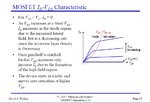pavan garate
Member level 3

I know that a MOSFET behaves like a resistor in Active Region, and has constant power consumption in Saturation Region.
My queries are-
1) Whether the MOSFET consumes more power in Active region or Saturation region?
2) If a MOSFET works in alternating Active & Saturation regions, what will be the effects on its power consumption?
3) Are the effects on power consumption different for NMOS & PMOS?
My queries are-
1) Whether the MOSFET consumes more power in Active region or Saturation region?
2) If a MOSFET works in alternating Active & Saturation regions, what will be the effects on its power consumption?
3) Are the effects on power consumption different for NMOS & PMOS?



